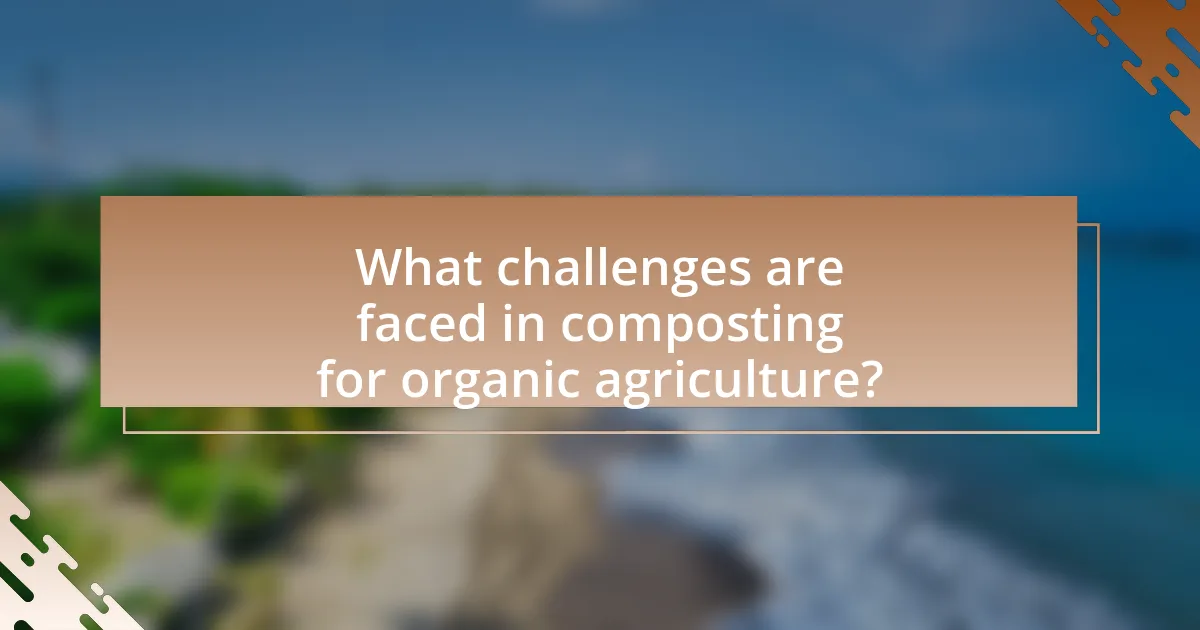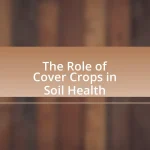The article focuses on best practices for composting in organic agriculture, emphasizing the importance of maintaining a balanced carbon-to-nitrogen ratio, proper aeration, and optimal moisture levels to enhance microbial activity and decomposition. It outlines how composting contributes to soil health by improving fertility, structure, and crop yields, while also detailing suitable materials for composting, including kitchen scraps and yard waste. Additionally, the article addresses challenges faced in composting, such as contamination and odor management, and provides strategies for optimizing composting processes across different climates. Key techniques for monitoring composting progress and troubleshooting common issues are also discussed, ensuring effective compost production for sustainable agricultural practices.

What are the Best Practices for Composting in Organic Agriculture?
The best practices for composting in organic agriculture include maintaining a balanced carbon-to-nitrogen ratio, ensuring proper aeration, and monitoring moisture levels. A carbon-to-nitrogen ratio of approximately 30:1 is ideal for microbial activity, which accelerates decomposition. Proper aeration, achieved by turning the compost regularly, prevents anaerobic conditions that can lead to odors and slow breakdown. Additionally, maintaining moisture levels between 40-60% is crucial, as too much moisture can lead to anaerobic conditions, while too little can inhibit microbial activity. These practices enhance compost quality, promote nutrient availability, and support sustainable agricultural practices.
How does composting contribute to organic agriculture?
Composting significantly contributes to organic agriculture by enhancing soil fertility and structure. The process of composting transforms organic waste into nutrient-rich compost, which improves soil health by increasing microbial activity and providing essential nutrients like nitrogen, phosphorus, and potassium. Research indicates that compost application can lead to increased crop yields, with studies showing yield improvements of up to 30% in some organic farming systems. Additionally, compost helps retain soil moisture and reduces erosion, further supporting sustainable agricultural practices.
What role does compost play in soil health?
Compost significantly enhances soil health by improving its structure, fertility, and microbial activity. The organic matter in compost increases soil aeration and water retention, which promotes root growth and nutrient uptake. Additionally, compost provides essential nutrients such as nitrogen, phosphorus, and potassium, which are vital for plant growth. Research indicates that compost application can increase soil organic carbon levels by 30% to 50%, thereby improving soil fertility and overall ecosystem function. Furthermore, compost enriches the soil microbiome, fostering beneficial microorganisms that suppress pathogens and enhance nutrient cycling.
How does composting affect crop yield and quality?
Composting significantly enhances crop yield and quality by improving soil structure, nutrient availability, and microbial activity. Research indicates that composted organic matter increases soil fertility, leading to higher nutrient retention and better water-holding capacity, which directly contributes to increased crop productivity. A study published in the journal “Agriculture, Ecosystems & Environment” found that crops grown in compost-amended soils exhibited yield increases of 20-30% compared to those grown in conventional soils. Additionally, compost improves the overall health of plants, resulting in higher resistance to pests and diseases, which further enhances crop quality.
What materials are suitable for composting in organic agriculture?
Suitable materials for composting in organic agriculture include kitchen scraps, yard waste, and agricultural residues. Kitchen scraps such as fruit and vegetable peels, coffee grounds, and eggshells provide nitrogen, while yard waste like grass clippings, leaves, and small branches contribute carbon. Agricultural residues, including straw, corn stalks, and other plant materials, also enhance the compost’s nutrient profile. These materials are effective because they decompose efficiently, enriching the soil with essential nutrients and improving soil structure, which is vital for sustainable organic farming practices.
What are the best green materials for composting?
The best green materials for composting include fresh grass clippings, vegetable scraps, fruit peels, coffee grounds, and green leaves. These materials are rich in nitrogen, which is essential for the composting process. For instance, grass clippings contain about 2.5% nitrogen, making them an excellent source for accelerating decomposition. Vegetable scraps and fruit peels also contribute significant nitrogen and moisture, enhancing microbial activity. Coffee grounds, with a nitrogen content of approximately 2.2%, further support the composting process. Green leaves provide additional nutrients and help balance carbon-rich brown materials, ensuring effective composting.
Which brown materials should be included in compost?
Brown materials that should be included in compost are carbon-rich items such as dried leaves, straw, wood chips, and cardboard. These materials provide essential carbon to balance the nitrogen-rich green materials, facilitating the composting process. For instance, dried leaves contain high levels of carbon, typically around 40-50%, making them an excellent addition to compost. Similarly, straw and wood chips contribute significant carbon content, which is crucial for microbial activity during decomposition.
How can composting processes be optimized for organic farming?
Composting processes can be optimized for organic farming by maintaining the right carbon-to-nitrogen ratio, ensuring adequate aeration, and monitoring moisture levels. A balanced carbon-to-nitrogen ratio, ideally around 30:1, promotes microbial activity essential for decomposition. Regular turning of the compost pile enhances aeration, which is crucial for aerobic bacteria that break down organic matter efficiently. Additionally, maintaining moisture levels between 40-60% prevents the compost from becoming too dry or too wet, both of which can hinder microbial activity. Research indicates that these practices significantly improve compost quality and nutrient availability, ultimately benefiting soil health and crop productivity in organic farming systems.
What are the ideal conditions for composting?
The ideal conditions for composting include a balanced mix of carbon-rich materials (browns) and nitrogen-rich materials (greens), adequate moisture levels, and proper aeration. A carbon-to-nitrogen ratio of approximately 30:1 is optimal for microbial activity, which accelerates decomposition. Moisture levels should be maintained between 40% to 60%, ensuring that the compost is damp but not waterlogged. Additionally, turning the compost pile regularly enhances aeration, promoting aerobic decomposition and preventing odors. These conditions create an environment conducive to the activity of microorganisms, which are essential for breaking down organic matter efficiently.
How does aeration impact the composting process?
Aeration significantly enhances the composting process by promoting aerobic decomposition, which is essential for efficient breakdown of organic materials. When compost is adequately aerated, oxygen levels increase, allowing aerobic microorganisms to thrive, leading to faster decomposition and higher-quality compost. Research indicates that maintaining optimal aeration can reduce the composting time by up to 50% compared to anaerobic conditions, which can produce foul odors and harmful byproducts. Therefore, effective aeration is crucial for achieving a successful composting outcome in organic agriculture.

What techniques enhance composting efficiency in organic agriculture?
Techniques that enhance composting efficiency in organic agriculture include maintaining optimal moisture levels, ensuring proper aeration, and utilizing a balanced carbon-to-nitrogen ratio. Maintaining moisture between 40-60% is crucial for microbial activity, which accelerates decomposition. Proper aeration, achieved through turning the compost pile regularly, promotes oxygen flow, preventing anaerobic conditions that slow down the process. Additionally, a balanced carbon-to-nitrogen ratio of approximately 30:1 supports effective microbial growth, as nitrogen fuels microbial activity while carbon provides energy. These practices are supported by research indicating that optimized conditions can reduce composting time and improve nutrient availability in the final product.
How can layering improve compost quality?
Layering improves compost quality by creating distinct strata that enhance aeration, moisture retention, and nutrient distribution. This method allows for the incorporation of diverse materials, such as greens (nitrogen-rich) and browns (carbon-rich), which promotes microbial activity and accelerates decomposition. Research indicates that a balanced carbon-to-nitrogen ratio, achieved through effective layering, can lead to higher temperatures in the compost pile, facilitating pathogen reduction and nutrient availability. Studies show that well-layered compost can yield a more uniform and nutrient-rich end product, supporting healthier soil and plant growth in organic agriculture.
What is the importance of the carbon-to-nitrogen ratio?
The carbon-to-nitrogen ratio is crucial in composting as it influences microbial activity and nutrient availability. A balanced ratio, typically around 30:1, promotes efficient decomposition, ensuring that microorganisms have sufficient carbon for energy and nitrogen for growth. When the ratio is too high in carbon, decomposition slows, leading to nutrient deficiencies in the compost. Conversely, a low carbon-to-nitrogen ratio can result in excessive nitrogen, causing odors and potential nutrient loss. Studies indicate that maintaining the appropriate ratio enhances compost quality, supports plant growth, and improves soil health, making it a fundamental aspect of best practices in organic agriculture.
How does moisture content affect composting?
Moisture content significantly affects composting by influencing microbial activity, which is essential for the decomposition process. Optimal moisture levels, typically between 40% and 60%, promote the growth of beneficial microorganisms that break down organic matter efficiently. When moisture is too low, microbial activity slows down, leading to incomplete composting and potential odor issues. Conversely, excessive moisture can create anaerobic conditions, resulting in a smelly, slimy compost that is less effective. Studies indicate that maintaining proper moisture levels can enhance compost quality and speed up the composting process, making it a critical factor in best practices for composting in organic agriculture.
What methods can be used to monitor composting progress?
To monitor composting progress, temperature measurement, moisture assessment, and visual inspection are effective methods. Temperature measurement involves using a compost thermometer to track heat levels, which indicates microbial activity; optimal composting temperatures range from 130°F to 160°F. Moisture assessment ensures that the compost maintains a moisture level between 40% and 60%, which is crucial for microbial processes. Visual inspection allows for the evaluation of the compost’s texture, color, and odor, helping to identify any issues such as anaerobic conditions or insufficient decomposition. These methods collectively provide a comprehensive understanding of the composting process, ensuring that it progresses efficiently towards maturity.
How can temperature be used as an indicator of compost health?
Temperature can be used as an indicator of compost health by reflecting the microbial activity and decomposition processes occurring within the compost pile. When compost is actively decomposing, temperatures typically rise between 130°F to 160°F (54°C to 71°C), indicating that thermophilic bacteria are breaking down organic matter efficiently. This temperature range is crucial for pathogen reduction and weed seed destruction, which are essential for producing high-quality compost. Monitoring temperature helps composters identify when to aerate the pile or adjust moisture levels to maintain optimal conditions for microbial activity, ensuring effective composting and overall compost health.
What signs indicate that compost is ready for use?
Compost is ready for use when it has a dark, crumbly texture, an earthy smell, and a temperature that has stabilized to ambient levels. These signs indicate that the organic materials have fully decomposed and are now rich in nutrients. The dark color results from the breakdown of materials, while the earthy smell signifies the presence of beneficial microorganisms. Additionally, a stable temperature, typically around the same as the surrounding environment, indicates that the active composting process has completed.

What challenges are faced in composting for organic agriculture?
Composting for organic agriculture faces several challenges, including the management of carbon-to-nitrogen ratios, contamination with pathogens or chemicals, and achieving optimal moisture levels. The carbon-to-nitrogen ratio is crucial because an imbalance can slow down the decomposition process, leading to ineffective compost. Contamination can occur from using non-organic materials, which may introduce harmful substances into the compost, undermining the organic integrity of the final product. Additionally, maintaining the right moisture level is essential; too much moisture can create anaerobic conditions, while too little can hinder microbial activity, both of which negatively impact compost quality. These challenges are well-documented in studies on organic composting practices, highlighting the need for careful management to ensure successful compost production.
What common pests and diseases can affect compost?
Common pests that can affect compost include fruit flies, rodents, and various insects such as ants and beetles. These pests are attracted to the organic materials in compost, which can lead to contamination and disruption of the composting process. Diseases that may arise in compost include pathogens like E. coli and Salmonella, which can survive in improperly managed compost. Research indicates that maintaining proper temperature and moisture levels in compost can help mitigate these issues, as high temperatures can kill many pests and pathogens.
How can farmers prevent contamination in compost?
Farmers can prevent contamination in compost by ensuring proper material selection and maintaining optimal composting conditions. Using only organic materials free from pesticides, herbicides, and pathogens is crucial, as these can introduce harmful contaminants. Additionally, maintaining the right balance of carbon to nitrogen, adequate moisture, and proper aeration promotes effective microbial activity, which helps break down contaminants. Regular monitoring of temperature is also essential; compost should reach at least 130°F (54°C) for several days to kill pathogens and weed seeds. These practices collectively minimize the risk of contamination, ensuring the compost remains safe and beneficial for agricultural use.
What strategies can be employed to manage odors during composting?
To manage odors during composting, implement strategies such as maintaining proper aeration, balancing carbon-to-nitrogen ratios, and monitoring moisture levels. Proper aeration, achieved through regular turning of the compost pile, promotes aerobic decomposition, which minimizes odor production. A balanced carbon-to-nitrogen ratio, ideally around 30:1, ensures efficient microbial activity, reducing the likelihood of foul smells. Additionally, maintaining moisture levels between 40-60% prevents anaerobic conditions that lead to odor issues. These practices are supported by research indicating that well-managed compost systems produce fewer odors and enhance compost quality.
How can composting practices be adapted to different climates?
Composting practices can be adapted to different climates by modifying the materials used, adjusting moisture levels, and altering the composting method. In hot climates, for instance, incorporating more carbon-rich materials like dry leaves can help retain moisture and prevent overheating, while in cold climates, adding nitrogen-rich materials such as kitchen scraps can accelerate decomposition. Additionally, using insulated compost bins in colder regions can maintain warmth, promoting microbial activity. Research indicates that temperature and moisture are critical factors in composting efficiency, with optimal conditions varying by climate, thus necessitating these adaptations for effective organic waste management.
What adjustments are necessary for hot climates?
Adjustments necessary for hot climates include increasing moisture retention and managing temperature effectively in composting processes. In hot climates, compost materials can dry out quickly, which can hinder microbial activity essential for decomposition. Therefore, incorporating materials with high water content, such as fresh green plant material or adding water regularly, is crucial. Additionally, turning the compost pile more frequently helps to aerate it and prevent overheating, which can occur due to high ambient temperatures. Research indicates that maintaining optimal moisture levels and temperature control can enhance microbial activity and improve compost quality, making these adjustments vital for successful composting in hot climates.
How should composting be managed in colder regions?
Composting in colder regions should be managed by insulating compost piles and using specific materials to maintain heat. Insulation can be achieved by surrounding the compost with straw bales or using a compost bin designed for cold climates, which helps retain warmth generated by microbial activity. Additionally, incorporating high-carbon materials like dry leaves or straw can enhance heat retention, while adding nitrogen-rich materials such as kitchen scraps can accelerate decomposition. Research indicates that maintaining a temperature of at least 130°F (54°C) is crucial for effective composting, as this temperature supports microbial activity that breaks down organic matter efficiently, even in colder conditions.
What are the best practices for troubleshooting composting issues?
The best practices for troubleshooting composting issues include monitoring moisture levels, ensuring proper aeration, and balancing carbon-to-nitrogen ratios. Monitoring moisture is crucial because compost should be kept damp but not soggy; ideally, it should feel like a wrung-out sponge. Proper aeration prevents anaerobic conditions that can lead to foul odors and slow decomposition; turning the compost pile regularly enhances airflow. Balancing carbon-to-nitrogen ratios, typically around 30:1, is essential for effective microbial activity; too much carbon results in slow decomposition, while too much nitrogen can cause odors. These practices are supported by research indicating that maintaining optimal conditions significantly improves compost quality and efficiency.
How can imbalances in compost be corrected?
Imbalances in compost can be corrected by adjusting the carbon-to-nitrogen (C:N) ratio, moisture levels, and aeration. To achieve a balanced C:N ratio, add high-nitrogen materials like grass clippings or food scraps if the compost is too carbon-rich, or incorporate high-carbon materials like dried leaves or straw if it is too nitrogen-rich. Maintaining moisture levels around 40-60% ensures microbial activity, so if the compost is too dry, add water or moist materials, and if too wet, mix in dry materials to absorb excess moisture. Additionally, turning the compost pile regularly enhances aeration, promoting aerobic decomposition and preventing anaerobic conditions that can lead to odors and slow breakdown. These practices are supported by research indicating that optimal C:N ratios and proper moisture levels significantly enhance compost quality and decomposition rates.
What steps should be taken if compost is not heating up?
If compost is not heating up, the first step is to check the carbon-to-nitrogen ratio, which should ideally be around 30:1. If the ratio is too high in carbon materials, add nitrogen-rich materials like grass clippings or kitchen scraps to promote microbial activity. Next, ensure adequate moisture; compost should be damp but not soggy, with a moisture content of about 40-60%. If the compost is too dry, add water gradually until the desired moisture level is reached. Additionally, aeration is crucial; turning the compost pile every few weeks introduces oxygen, which is necessary for aerobic decomposition. Lastly, check the pile size; a compost pile should ideally be at least three feet in height and width to retain heat effectively. These steps are supported by composting guidelines from the U.S. Environmental Protection Agency, which emphasize the importance of proper balance and management for effective composting.










